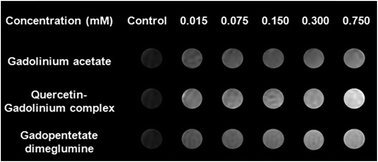Evaluation of a quercetin–gadolinium complex as an efficient positive contrast enhancer for magnetic resonance imaging†
Abstract
The need for a highly effective contrast agent that aids in distinguishing normal and affected cells is in great demand in clinics for accurate diagnosis. In this context, the present study attempts to utilize the metal ion complexation capacity of a pharmacologically relevant dietary flavonol, quercetin for development of a novel MRI contrast agent. The flavonoid–metal complex was synthesized using quercetin dihydrate and gadolinium acetate and characterized by elemental analysis, spectroscopy techniques, thermal analysis and powder XRD. The quercetin : gadolinium stoichiometry was determined to be 1 : 1 using Job's plot analysis and the equilibrium stability constant of metal binding to quercetin determined from fluorimetric analysis using Stern–Volmer equations indicated excellent stability. The magnetic properties of the complex were typical of a paramagnetic material as confirmed using vibrating sample magnetometry. The antioxidant property of the quercetin–gadolinium complex was greater than that of its parent ligand when evaluated by DPPH assay due to the structural changes. Cyclic voltammetry studies of both quercetin and its gadolinium complex were performed to confirm complexation and anti-oxidant potential. The viability of cancer cells, MCF7 and normal L929 cells remained unaffected after exposure to the complex. The efficacy of this complex as a positive contrast agent in MRI was evaluated using phantom agar gel assay and in vitro studies. It was found to exhibit superior positive contrast when compared with the commercially available contrast agent. This complex therefore may be evaluated further as a novel MR contrast agent for pre-clinical and clinical applications.


 Please wait while we load your content...
Please wait while we load your content...